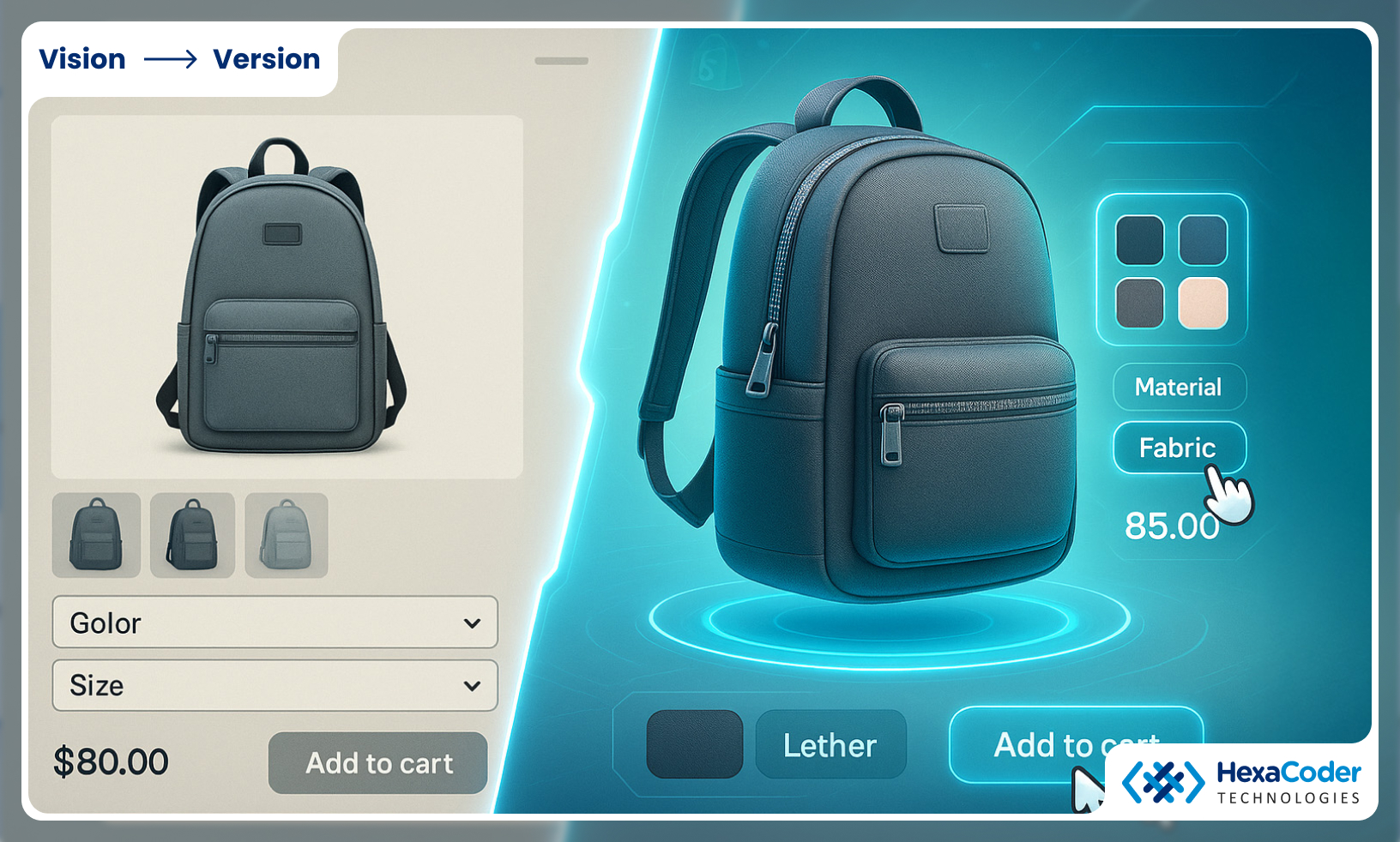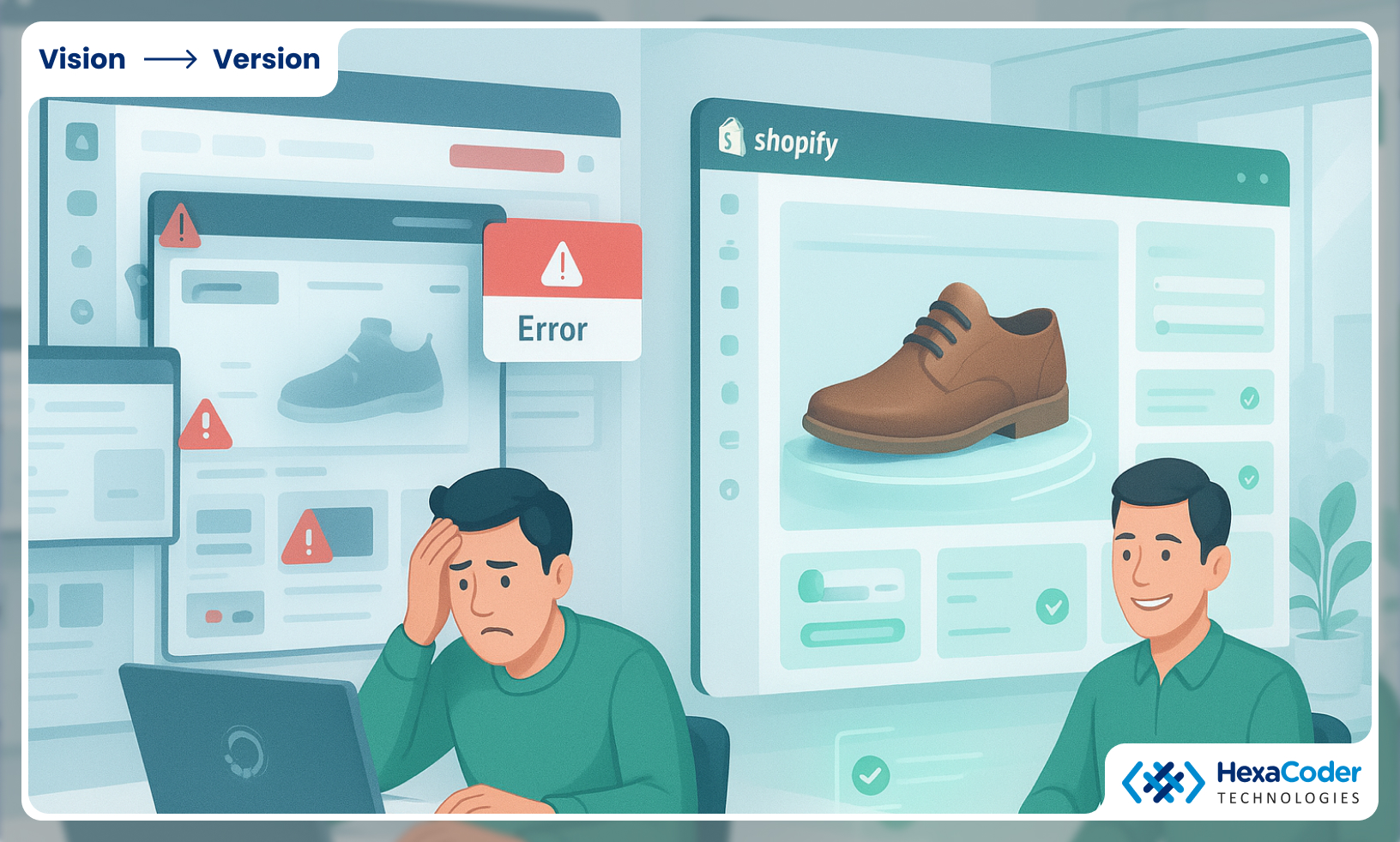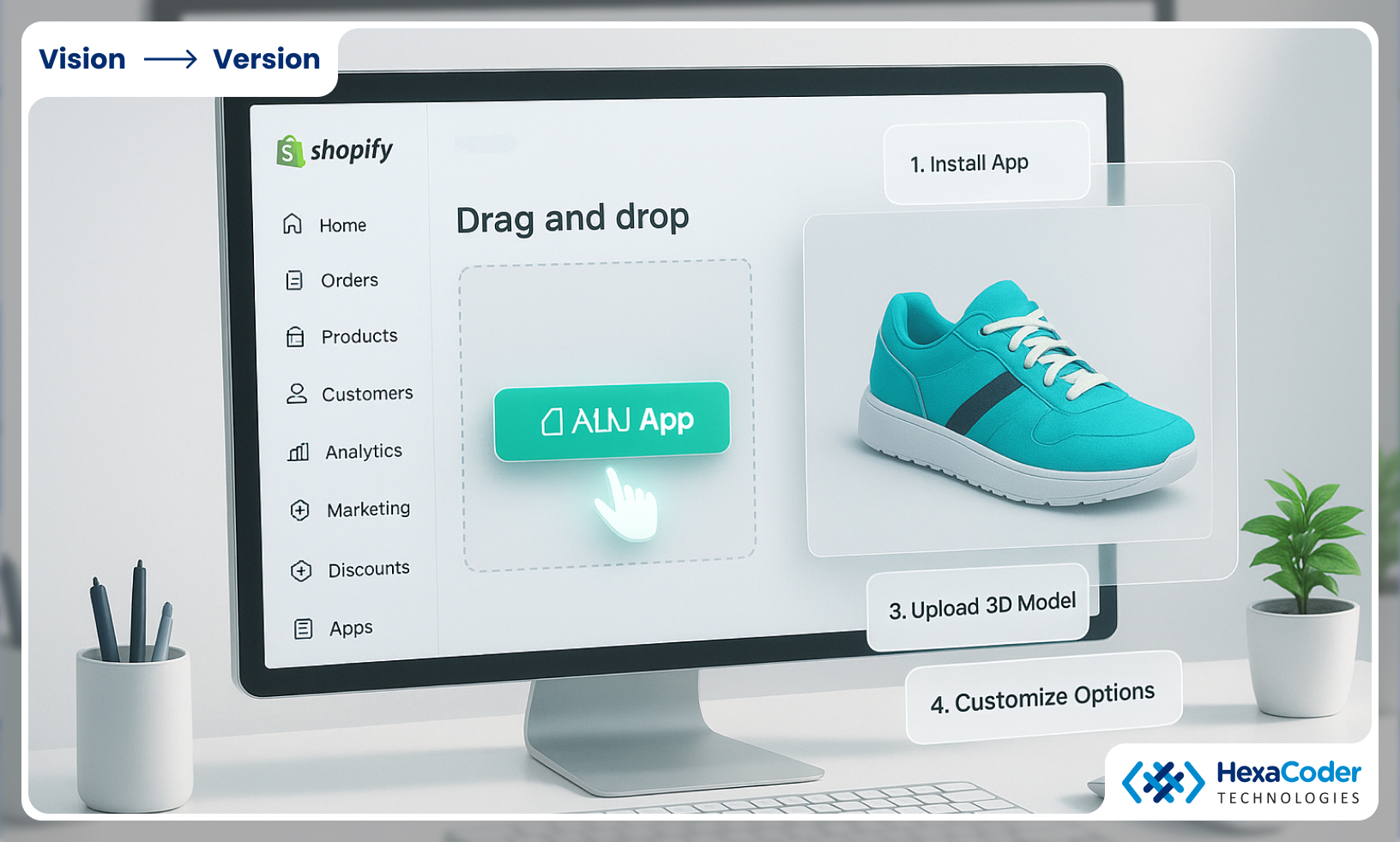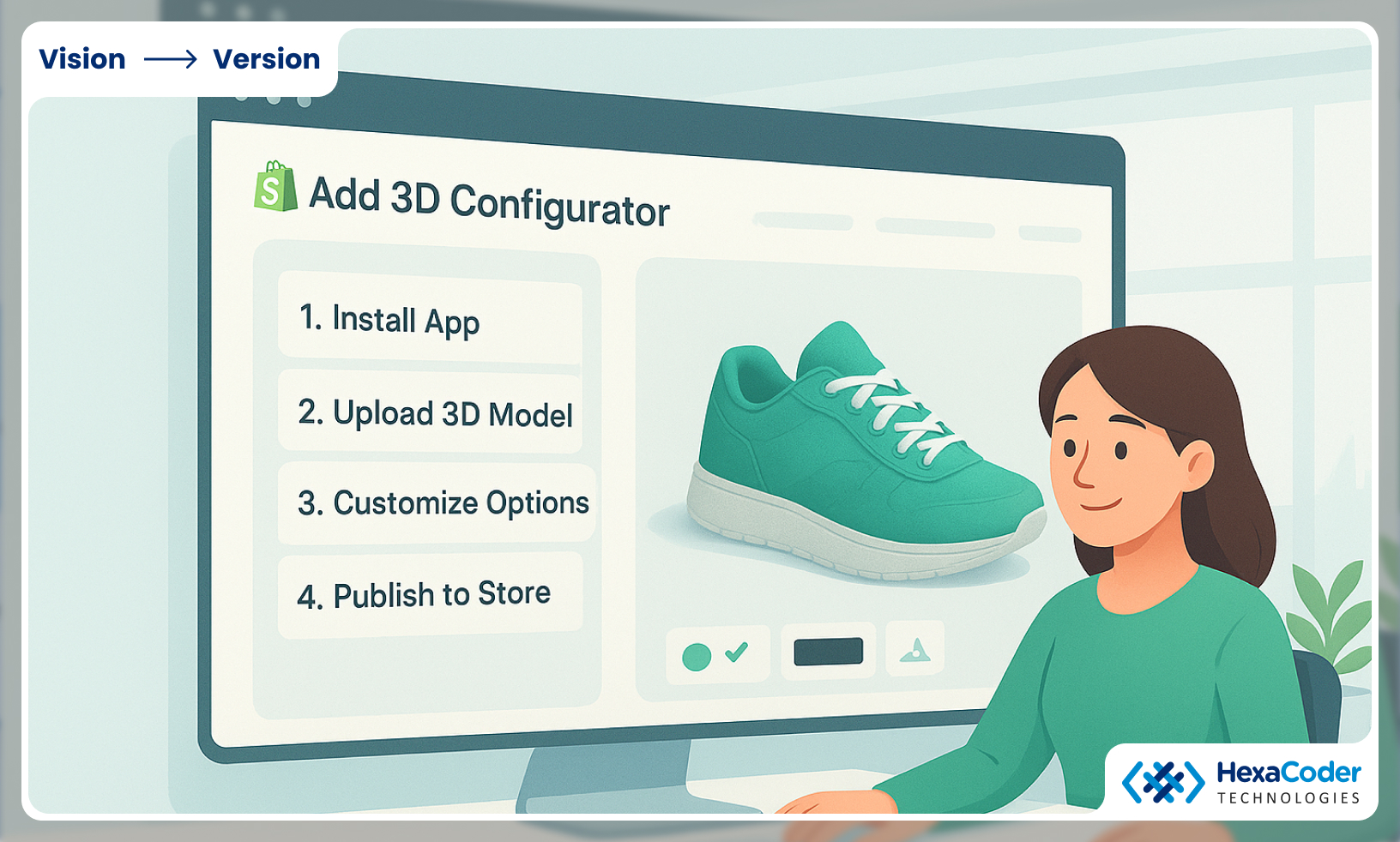Introduction
Purchasing products from an online store is simple and easy but it sometimes feel like you are deceiving yourself. You indefinitely ask yourself questions like, Will I pay for this blindly? Will this product meet my expectations? Why is my trust like this? Most customers, because of that doubt, close their web browser and abandon the shopping cart.
That is where the 3D configurator comes in. Rather than offering the client images that cannot move, this service enables them to examine the entire product. Users are able to spin the product, zoom in or out, change the color, or even customize the product before actually purchasing it. Now, your Shopify store does not just sell, but also successfully promotes their products.
This article will focus on:
- The 3D configurator: what is it and its value.
- The advantages It offers for your Shopify store.
- How to implement it step by step.
- Which tools are most relevant if you wish to achieve optimal outcomes.
If you aim to differentiate yourself from the competition, then this is it.
What Exactly Is a 3D Configurator?
A 3D configurator goes beyond being simply a high-tech add on. It allows users to overcome the barrier of digital interaction and engage with the product almost as if it were physically there. Rather than scrolling through dozens of photographs, they can spin the product, zoom, and in some cases, real time change a variety of features such as color, size, and material. It is like the difference between viewing.
Shopify store owners, in particular, ought to take notice. Why? Competition is fierce, and most stores still employ the same tired static product images. Placing a 3D configurator will give customers a reason to linger longer, dig deeper, and believe in your brand more. In an overcrowded market, being different isn't about offering great products, it's about providing a richer, more rewarding shopping experience.Why Your Shopify Store Needs a 3D Configurator
If your Shopify store feels like it’s blending into the background, you’re not alone. Thousands of online shops are competing for the same customers, often with the same tired product photos and generic descriptions. A 3D configurator is your way out of that noise, it doesn’t just look good, it pays off in real business results.
- Higher Conversions
Customers will click the "buy" button more when they are secure. There is no doubt when there is a 3D configurator because it shows products in all angles and allows customers to customize. When customers are able to see the exact blue on a sofa or the way an inscription on a ring would look, doubt disappears.
- Less Returns
Returns are the silent e-commerce profit killer. Shoppers return goods mainly because they fail to impress. Due to a 3D configurator, expectations are as clear as day, what you see is what you get. That clarity halves returns and saves you money and migraines.
- A Premium Customer Experience
Online buying is not transactions, it's experience. Allowing customers to experience the products gives ownership prior to a purchase. It's high-end feel, even if the product is not luxury-branded.
- Differentiation from the Competitors
Let's get real: the majority of Shopify stores are all alike. Same templates, same images, same marketing strategies. A 3D configurator distinguishes your store from the crowd. Instead of scrolling over, shoppers stop, explore, and remember you. That kind of distinction is marketing gold.
The truth remains that your Shopify store does not have to be a 3D configurator nice-to-have, but a growth driver. It makes you sell more, lose less on returns, and build a brand that is modern, credible, and irresistible.
Who Can Benefit from It?

A 3D configurator is an all-in-one. It's an omnibus solution, a multipurpose tool that can be applied in many different fields so that companies are able to show their products naturally to their clients. These are some of the fields where it shines most vividly:
- Fashion and Apparel
Ever shopped for a shirt online and wondered if the color or pattern will truly appear like that in real life? A 3D configurator takes care of it by letting consumers switch colors, try out different designs, and view the product from around before they buy. It's like giving your customers a dressing room, minus the awful lighting.
- Furniture and Home Décor
Buying a sofa or a table over the Internet is dicey. But if consumers can visualize a product in 3D, they can view furniture from any angle, check out texture, and even visualize it in their living room. That kind of openness eliminates risk and gives consumers confidence.
- Jewelry and Accessories
It's about personalization here. Customers are able to preview inscriptions in advance, trade stones, or view different metal finishes in real time. The result? A piece of jewelry that gets personalized well ahead of the time when it reaches their doorstep.
- Electronics and Gadgets
When consumers are comparing shopping on specifications and features, static images just won't cut it. The configurator enables them to toggle between options, i.e., colors, memory settings, or add-ons, and instantly see the product transform. It turns high-tech shopping into touch-and-feel.
In all these businesses, the value is the same: customers are more enabled, more interactive, and more prone to buy. For Shopify sellers, that means fewer doubts, less return, and more exposure for your brand in a crowded e-commerce environment.
How to Add a 3D Configurator to Shopify

It might look intimidating to include a 3D configurator to your Shopify site, but believe me, it is as easy as pie if you know the way. You don't need to be a master coder nor spend a fortune on a coder, the software is ready for you to implement. This is how:
- Select the Right Shopify App
First, find a 3D configurator application that you can use in your business. Shopify's app store has several options, from plug-and-play software to more advanced platforms with the capability to generate AR previews. In choosing an application, weigh your budget, how much customization you need, and if you also want additional features like AR previews.
- Upload or Create 3D Product Models
Your configurator needs 3D models of your products to operate. If you already have models, some apps enable you to upload them. Others offer model-making functionality from product images. On more expensive items, like furniture or jewelry, it's advisable to spend a bit more on professionally made models for a seamless experience.
- Integrate With Your Product Pages
Once you have configured the models, you may then install the configurator on your product pages. The majority of applications are drag and drop or easy to install, so you won't be required to code in it. You would like it to be seamless, when someone is clicking a product, the 3D view would open naturally without page delay.
- Test Across Devices
Your customers are not only shopping from laptops. Additional customers shop on mobile or tablets, so test carefully how the configurator looks and works on different screens. A tool that crashes or freezes on a mobile can kill sales in minutes. Smooth, responsive performance inspires trust and keeps buyers on your site.
- Fine-Tune and Promote
Having a configurator is just half the battle. Be sure to promote it, highlight it on product pages, highlight it in social media posts, and even create short demo videos showing usage. The more people who know about it, the more they'll utilize it.
Simple and fast, fitting a 3D configurator to Shopify is not rocket science, it's a step-by-step upgrade that turns your webstore into an interactive showroom. Good on ya, it delivers genuine value for your buyers and measurable returns for your company.
Best 3D Product Configurators for E-commerce

Not all 3D configurators are created equal. Some are simple plug-ins designed for smaller shops, while others are robust platforms built for brands with hundreds of products and advanced customization needs. If you’re a Shopify merchant looking to add this feature, here are some of the best options on the market:
- Hexacoder
Hexacoder provides an interactive, robust 3D configurator with real-time visualization, AR previews, dynamic pricing, and seamless integration with Shopify and other platforms. Rather than being a monthly SaaS tool, Hexacoder delivers a fully custom solution with a one-time development fee, including dedicated admin systems and advanced integrations. This approach serves businesses wanting unique branded control, scalability, and future-proofing as they grow.
- Threekit
Threekit is commonly known as the "gold standard" of 3D and AR shopping. It lets you build very accurate models of products and enables real-time customization for customers. It integrates with Shopify, among others, so it's a good option if you're planning on growing long term. The catch? It's more expensive, so it's best for established brands with a bit of an endowment.
- Zakeke
Zakeke is a favorite with Shopify customers because of the ease of install and newbie-friendliness of it. It has 3D views, AR previews, as well as product personalization in the form of text or image uploads. Small and medium-sized enterprises love it because it is so cheap yet still offers sufficient features. It does not overwhelm you with complexity and yet still offers a slick experience.
- Expivi
Expivi is for businesses that thrive on customization. Envision jewelry, furniture, or electronics with lots of choices. Its strength is showing multiple configurations at once, no cringe-worthy reloads, just smooth changes. The platform even supports pricing rules, so you can establish prices to change automatically as customers customize their perfect product.
- Vectary
In case you require flexibility, Vectary is well worth a look. You can actually make 3D models from within the platform and then embed them in your Shopify store. There is more design work involved than with plug-and-play products, but it's perfect for sellers who prefer to have control over what they're making.
- Shopify's Native 3D Model Support
You can overlook the fact that Shopify natively supports 3D models without the need for any add-ons. If you're keeping things basic, you can upload 3D files directly to your product pages. It might not be as immersive as having full configurators, but it's a cost-free entry point for merchants looking to dip their toes into 3D commerce.
Which One Do You Use?
The choice will depend on your store size and goals. Smaller stores may favor Zakeke for cost, whereas larger brands with more mature requirements may find Threekit or Expivi to be the better value. The choice is to pick an instrument that enhances the shopper's buying experience without slowing down your store or spending your budget.
Challenges & Mistakes to Avoid with 3D Configurators
Even with all the flashy gadgets, there are black areas, and 3D configurators included. Although they can turn your store into a virtual playground, haphazardly setting it up or diving in without preparation can mean more problems than dollars. The following are some of the common pitfalls Shopify sellers need to avoid:
- Overcomplicating the experience
Consumers don't need to engage in a puzzle-solving game while making their way to the checkout. A ten-click configurator or more steps before it shows results will push consumers away. Balance is the key: offer options without suffocating your consumer.
- Excluding mobile shoppers
A large chunk of online shoppers live on their phones. If your configurator only looks good on the desktop, you’ve already lost half your audience. Optimizing for mobile isn’t optional, it’s survival.
- Ignoring load speed
Nothing kills excitement faster than a spinning wheel. Heavy 3D models and uncompressed assets can slow your store to a crawl. Shoppers don’t have patience for that; they’ll bounce before your masterpiece appears.
- Not integrating with checkout
A great 3D experience is for naught if customers can't just add the product customized to the cart and buy. Configurators must be integrated with inventory, pricing, and checkout. Less is a leaky bucket.
- Leaving out customer support
Not all consumers are tech-savvy. Some will get stuck, lost, or overwhelmed. Without guides, FAQ, or support chat in view, you invite lost sales.
- Operating it as a "set it and forget it" machine
3D configurators are not set-it-and-forget-it toys. Products shift, designs evolve, and tastes change. If you don't update your models and stay current, the tool will age faster than you can utter the phrase "marketing gimmick artist."
Avoiding these dangers prevents your configurator from being perceived as a gimmick and makes it a genuine moneymaker.
Fixes in a Hurry for Configurator 3D Optimization

- Advertise it everywhere
Don't hide your configurator on a product page. Showcase it in emails, social media, and banners, customers need to know it exists in order to use it.
- Streamline
Too many options can be daunting. Showcase the features that matter most to your crowd.
- Test on a regular basis
Test mobile, tablet, and desktop functionality. Seamless functionality equals happier customers.
- 4. Refresh models regularly
As your products evolve, so should your 3D models. New designs keep the experience new.
- Gauge the impact
Track sales, use, and returns to measure how the configurator is affecting your business. Use that information to refine your setup.
The Future of 3D Product Configurators
3D configurators aren't something that will pass with the passage of time, they are the future of e-commerce. With virtual reality (VR) and augmented reality (AR) becoming the new norm of routine shopping, configurators will be immersing experiences where the consumer gets to place the product into his/her own environment before it's bought.
AI personalization will advance this further. Instead of having to start from scratch, a configurator can provide top fashions or even anticipate what a consumer is seeking based on how they have been surfing.
Being a Shopify merchant, the sooner you make use of a 3D configurator, the better will your advantage for future online shopping be. What we view as a competitive edge today will be normal sooner than later.
E-commerce is evolving faster than most stores can keep up. Virtual reality and augmented reality aren’t “coming soon”, they’re already shaping how customers expect to shop. A 3D configurator is no longer a shiny add-on; it’s the difference between being chosen or ignored.
At Hexacoder Technologies, we build the tools that put your Shopify store ahead of the curve. Our custom 3D configurators and smart personalization features help you turn browsers into buyers, and buyers into loyal customers.
Don’t wait until tomorrow’s standard makes today’s advantage disappear. Partner with Hexacoder now and own the future of online shopping.





